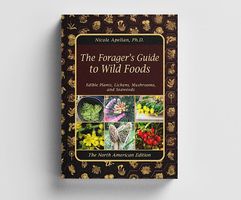
The Forager’s Guide To Wild Foods Review
The Forager's Guide to Wild Foods is an indispensable resource. Even seasoned foragers may sometimes hesitate when identifying a plant in the wild, and having this book by your side can make all the difference. For those just starting out, it serves as a reliable guide to discovering nature’s bounty with confidence and safety.
This comprehensive guide belongs in every household, ready for emergencies or simply for the joy of connecting with nature. Keep it alongside your emergency supplies, in your Bug Out Bag, or even on your coffee table—it’s that versatile.
What Is The Forager’s Guide to Wild Foods?
This guide explores over 400 medicinal plants native to North America, many of which are overlooked or misunderstood. Nicole emphasizes the critical ability to distinguish between beneficial wild foods and those that may be irrelevant or even harmful.
Unlike other foraging books, Nicole's approach focuses on clear identification and practical application. What’s more, these plants are often found in accessible locations—backyards, forests, even city streets. Her guide is designed not just to inform but to empower readers with practical skills for foraging and using these plants effectively.

About the Author: Nicole Apelian, Ph.D.
Dr. Nicole Apelian brings a wealth of expertise to this book. She is a renowned herbalist, biologist, anthropologist, wilderness skills instructor, and survival consultant. Her personal journey adds depth to her professional credentials. In 2000, Nicole was diagnosed with multiple sclerosis, a turning point that motivated her to explore holistic wellness for her own healing.
By fostering a connection with nature, practicing gratitude, embracing a healthy diet, and utilizing herbal remedies, she overcame significant challenges, transforming her life. Nicole's story, from being bedridden to thriving, underscores her belief in nature’s power to heal and sustain.
Key Features of The Forager’s Guide To Wild Foods
Nicole has poured her expertise and passion into this guide, creating a resource that's as visually engaging as it is informative. Here are some standout features:
1. Clear, Detailed Visuals
Accurate identification is crucial in foraging, and the book excels in this area with large, colorful images of plants taken from multiple angles. These visuals make it easier to recognize plants’ key characteristics. Nicole also includes distribution maps to simplify the search process.
2. Differentiating Beneficial and Dangerous Plants
Many plants share similar appearances, but their effects can vary dramatically. Nicole tackles this challenge head-on by organizing the book into sections that compare edible or medicinal plants with their toxic look-alikes. This attention to detail is vital, as misidentifying a plant can have serious consequences.
3. Comprehensive Educational Content
This guide goes beyond identification to include:
- Medicinal uses of plants.
- Instructions for harvesting at the right time.
- Remedies for common health issues.
- Delicious, tested recipes to incorporate wild foods into your diet.
Nicole’s holistic approach sets this guide apart by making it both a reference and a practical tool for everyday use.
Final Thoughts
Nature offers an abundance of wild foods and medicinal plants, many of which go unnoticed in our daily lives. *The Forager’s Guide to Wild Foods* opens readers’ eyes to this hidden world, providing clear guidance on how to forage safely and sustainably.
With this book, you’ll gain skills that can last a lifetime—whether you’re replacing harmful processed ingredients in your meals or preparing for uncertain times. Nicole Apelian’s expertise and dedication make this guide an invaluable addition to any home.